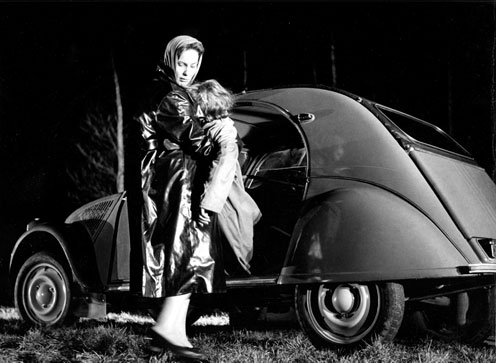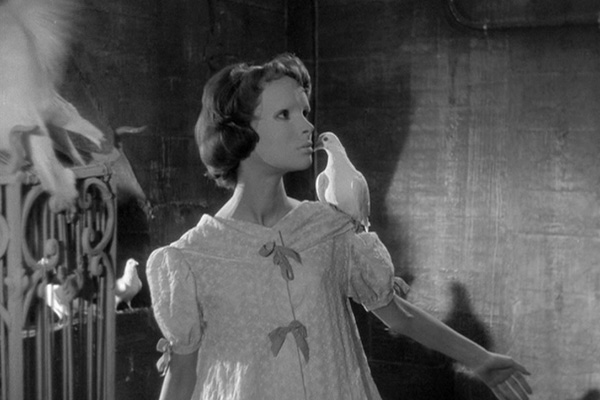
Why do we watch movies? It’s a simple question with an entire bookshelf worth of answers. There are so many reasons: To cheer up, to laugh, to cry, to get scared, for an ego boost, for an assist in the romantic process, for smartening up, for dumbing down, for an education, for wasting time, for monsters or pretty girls or explosions or a look into a past that doesn’t exist anymore. And sometimes it’s about the imagery.
I saw Georges Franju’s EYES WITHOUT A FACE only once, almost fifteen years ago, and yet there are several images from the film that have stayed with me. There are movies with dialogue I can recite by heart from start to finish, and then there are movies like this one, which only needed a single viewing to plant root in my consciousness. EYES WITHOUT A FACE is a film that haunts.

The story is centered around a ghostly young woman named Christiane (Edith Scob), who was horribly disfigured in a car accident. Christiane roams the halls of the family mansion wearing a white mask that covers her every feature, besides her eyes. Her father, a wealthy surgeon, is dedicated to reconstructing his daughter’s face, to the point where he abducts and subdues young women in order to attempt elaborate skin graft procedures, swapping their faces onto Christiane’s. The experiments have varying degrees of success, but are never permanent.
The essential theme of the movie is that Christiane is a prisoner of her father, who has lost all humanity in pursuit of his goal and is more concerned with scientific success than his daughter’s comfort and recovery. And despite the disturbing countenance of Christiane, with and without her mask (but mostly with), there is a purity and a strange beauty to her that makes these experiments hardly necessary.
But more than anything, what you’ll remember are the images. Georges Franju, the director, had a history of non-fiction filmmaking before this, his second feature. He made documentaries about factories and veterans’ hospitals (this not long after World War II) and, most pertinently to some of the most squirm-inducing scenes in EYES WITHOUT A FACE, slaughterhouses. The grisly, lengthy face-transplant scenes are shot by Franju with an unblinking eye, almost as if it unfazes him and he expects it not to faze us, his audience, either. That’s filmmaking as character – the evil doctor would look at his subjects that way. These scenes would be upsetting enough here in 2012, after five decades of gore films – just imagine what they would have felt like back in 1960!

Franju has a lyrical eye as well, though – those scenes of Christiane gliding through the darkened corridors of a mansion too large for its occupants, with orchestral accompaniments by Maurice Jarre, are as eerie as any ghost story. These sequences are as simultaneously creepy and pretty as other sequences, most notably the final fate of the doctor, are savage. It’s an indelible juxtaposition, and that’s why this film is so well-remembered despite initial misunderstanding, disinterest, and disgust. Hilariously, according to Wikipedia, EYES WITHOUT A FACE was originally screened in the States on a double-bill with THE MANSTER. Most people in 1960 didn’t know what they had: A true work of cinematic art.
EYES WITHOUT A FACE is also an important film for readers of this site due to the profound influence it has had – the second you see Christiane, you know exactly where John Carpenter got the inspiration for Michael Myers’ mask in HALLOWEEN. Yes, we all know the apocryphal story of how Carpenter’s art director, Tommy Lee Wallace, used a William Shatner mask and melted it down in order to create Myers’ featureless mask, that spooky pale death’s head with only openings over the eyes to indicate the scant humanity within. But the image, see, the image, that’s EYES WITHOUT A FACE. It got into John Carpenter’s head too.

When I first saw EYES WITHOUT A FACE way back when, it wasn’t long after FACE/OFF had come out, and it could be said that the face transplant scenes in that film were also influenced by Franju’s film, but I’m not so sure. John Woo cut away quickly from the face transplants in FACE/OFF (or was forced to by studio test screenings, who knows). EYES WITHOUT A FACE, on the other hand, showed the operations in all their awfulness. Despite my adoration of John Woo, or in fact as a statement of how impressive Franju’s unflinching method is, I have to say that, in this respect at least, FACE/OFF is a pussy next to EYES WITHOUT A FACE.
The Billy Idol song, however, is absolutely a response to this movie. Whether that is a virtue or a travesty is in the ears of the beholder.
Sorry – eyes. I meant eyes.
@jonnyabomb
- [THE BIG QUESTION] WHAT’S YOUR FAVORITE FEMALE ENSEMBLE IN MOVIES? - July 22, 2016
- [IN THEATERS NOW] THE BOY (2016) - January 24, 2016
- Cult Movie Mania Releases Lucio Fulci Limited Edition VHS Sets - January 5, 2016





No Comments